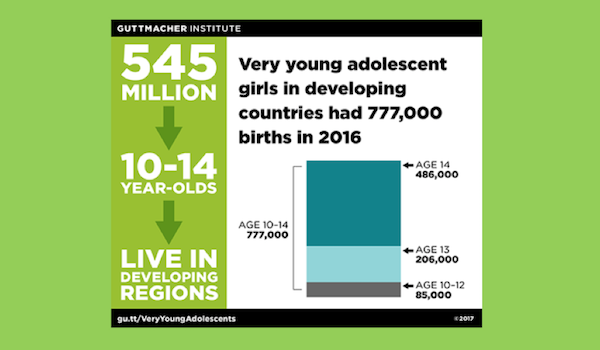
by Vanessa Woog, Anna Kågesten
Guttmacher Institute Report, May 2017
Early adolescence is a time of physical, social, emotional and cognitive changes, including the onset of puberty and, for some, the initiation of sexual activities. It is therefore a critical time to lay the foundation for healthy and fulfilling sexual and reproductive lives.
This report draws on analyses of national survey data and literature review results to provide an overview of the evidence on key aspects of sexual and reproductive health among very young adolescents aged 10–14 living in developing regions.
Many developing countries have national policies and curricula that support comprehensive sex education (CSE) in primary schools; however, available data tell us little about the extent to which 10–14-year-olds are actually receiving CSE, or about the quality of such education. While most very young adolescents report that they have never experienced sexual intercourse, some have begun to explore intimate relationships and to engage in non-coital sexual activities, such as kissing, hugging, fondling, and oral and anal sex.
For many, first sexual intercourse happens as a result of coercion or violence. Between 3% and 23% of adolescent females aged 13–17 report experience of sexual violence in the past year; it is 0–13% among adolescent males.
The proportion of adolescent females married before age 15 varies by country – from less than 1% to 24% – as well as by region, residence and wealth. The United Nations Population Fund estimates that between 2011 and 2020, 50 million girls in developing countries are at risk of being married by age 15.
“Preventing sexual violence is critical to protecting very young adolescents’ sexual and reproductive health and their long-term well-being,” says Anna Kågesten, independent consultant and co-author of the report. “The prevalence of sexual violence in young adolescents’ lives points to the urgent need to scale up programs that address the root causes of gender-based violence, including those that promote equitable gender norms.”
The researchers urge program planners and policymakers in developing regions to prioritize evidence-based interventions that have been shown to meet the SRH needs of very young adolescents. Suggested areas of focus include increasing the availability of youth-friendly SRH services among adolescents, keeping very young adolescents – particularly girls – in school, implementing national CSE policies and curricula, and addressing the structural and social causes of gender-based violence and child marriage. The authors also highlight the pressing need for more data specifically on 10-14-year-olds’ sexual and reproductive health. More data are also needed on the experiences and needs of young adolescent males, and those of the most vulnerable groups of very young adolescents – to inform programs and policies aiming to effectively meet the SRH needs of every very young adolescent.
Fact Sheet in French, Spanish ; Infographic in French, Spanish



